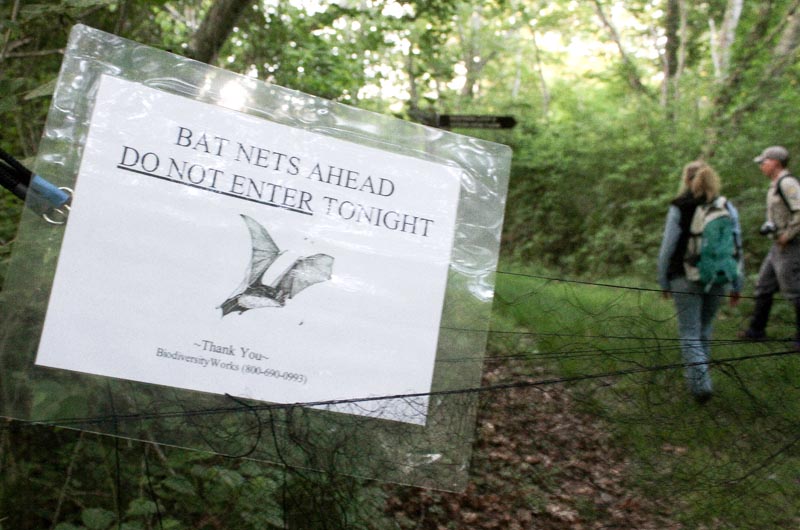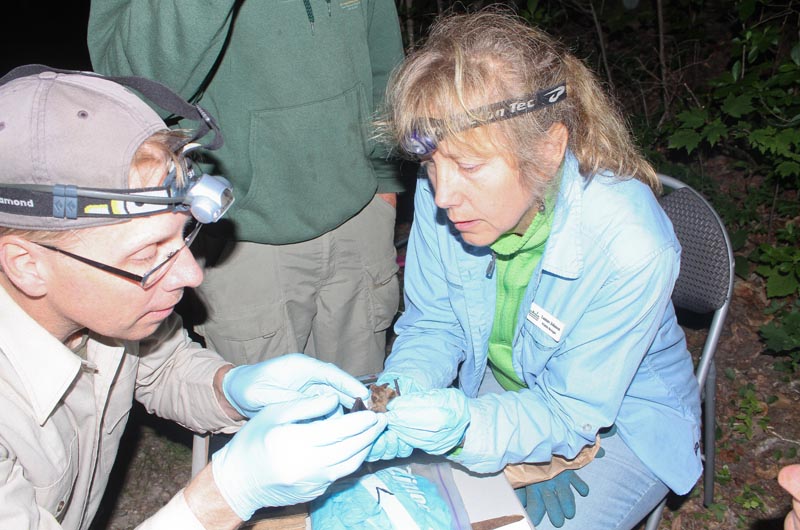It was dark in Chilmark and the birds in the trees had stopped calling. A faint sliver of a moon was rising somewhere above the canopy of trees at Fulling Mill Brook preserve, where four people stood near a fork in one of the leaf-covered paths that crisscross the property. Off the path and to the left was a bridge with a fast-flowing stream rushing beneath it. Temperatures had dropped to 55 degrees.
“Is there a point when it gets too cold?” wondered Dave Bouck, a seasonal wildlife biologist with BiodiversityWorks. Director Luanne Johnson stood next to him, wearing a headlamp. She had been out on the trails for two hours setting up for the evening’s work.
“I was catching here in April and October,” said Kendra Buresch, a researcher based in Woods Hole. It had been more than 15 years since Ms. Buresch had done work at Fulling Mill Brook, but her memory was as clear as if she’d been walking the trails the day before.
“Now that they’re lactating, they’re probably out whether it’s 55 or not,” U.S. Department of Fish and Wildlife biologist Jon Reichard said. The group split up. Mr. Reichard and Ms. Buresch walked south. Ms. Buresch held a rectangular box resembling a small slide projector in one hand — a bat detector. On the way back from their walk, the box made a series of sharp buzzes, one after another.
“When it’s checking something, all the calls get closer and closer together,” Mr. Reichard said. But the buzzes came further apart and then disappeared altogether. Mr. Reichard and Ms. Buresch kept walking.
When they returned to the fork, they found Ms. Johnson near the bridge, headlamp shining on a small bat caught in the fine nylon mesh of a net stretched across the path. The little animal bit Luanne’s glove as she worked to free it, chittering as loudly as it could, which was not very loud at all. Its fuzzy face was dwarfed beneath two huge ears, and when it wasn’t trying to make noise it opened its triangle-shaped mouth to show rows of sharp pointy teeth and a bright pink tongue. Its biggest teeth, the canines, were smaller than poppy seeds.
A healthy female, and fully grown despite its size, the entangled bat had a belly full of insects from the night’s hunting and a nursing pup to get back to. It bit Ms. Johnson’s glove again and again, but its tiny mouth couldn’t even fit around a pinky finger.
“She flew in from the stream,” Ms. Johnson said to the group.
It was exactly what they were looking for: Myotis septentrionalis, a northern long-eared bat. The night before, two other female northern long-eared bats were caught at the Hoft Farm in West Tisbury. Like the Fulling Mill Brook bat, they were lactating, which meant they had pups and that there was a breeding population on the Vineyard.
On the mainland, northern long-eared bats are quickly becoming rare sights. They, along with many other species of bats, have fallen victim to a disease called white-nose syndrome, which has killed nearly six million bats since it was first observed in North America in a cave near Albany in 2006. Caused by a recently identified fungus named Pseudogymnoascus destructans that grows on the muzzle in white patches, the disease affects hibernating bats. It creates lesions on their skin, which can form holes in their wings. It also causes them to wake up during hibernation and fly out of their caves in search of food. But there is little food available for bats in the winter — insects are few and far between — and their bodies are not equipped to deal with cold and fluctuating winter temperatures. Hibernation requires the stable temperature of a cave, and a little help from the heat of hundreds of bats huddled together.
“They hibernate close together, which is why white-nose spread so quickly,” Ms. Buresch said.
Since white-nose syndrome was first identified, the northern long-eared bat population has suffered so much — some areas have lost up to 99 per cent of their numbers — that the bat is being considered for listing as an endangered species. A final determination is expected before April of next year.
But while white-nose syndrome has ravaged the eastern United States and has now been found as far south as Alabama and as far west as Missouri and Wisconsin, it has never been documented on Martha’s Vineyard. The bats here are safe, at least for the time being.
“We’re here to see if this is a stronghold,” Mr. Reichard said. He was working toward his PhD when white-nose was first identified in Massachusetts, and he’s now the national assistant coordinator for the disease. Mr. Reichard and U.S. Fish and Wildlife endangered species biologist Susi von Oettingen were on the Island for two days, partnering with BiodiversityWorks as part of a grant-funded effort to learn more about the Vineyard’s northern long-eared bats.
The population here is demonstrably adaptable. Over the past two years, they’ve been observed roosting in bluebird boxes, which had never been seen before in the species, Ms. Johnson said. Last summer an early effort to establish a record of the population here found northern long-eared bats at six different sites. That program relied exclusively on audio data collected by the bat detectors, which record sonar as bats hunt and echolocate.
“We need to get them in our hands and [formally] document that they’re here,” Ms. Johnson said. “Then we can move on to bigger and better plans.” Data from the project would be used as part of the overall endangered species listing effort as well as the effort to better understand white-nose syndrome.
“It came from elsewhere, as far we know,” Mr. Reichard said of the disease. The germ that causes the disease is just about everywhere, he said, but white-nose syndrome itself is not.
“We do know that we’ve seen [the disease] all over Europe,” he said.
Earlier in the day, the group had set out mist nets, the long mesh nets placed across flyways where bats were known to be active while feeding. Birds can also be caught via mist netting, but those nets are made of cotton. Bat nets must be made of nylon because the animals will try to eat through the mesh once they’re tangled in it.
The mist nets are barely visible to the human eye when they’re set (and occasionally they do snare unsuspecting humans; the bat group put out signs to warn off any joggers and hikers). They’re not wholly invisible to bats, which can also detect a net via echolocation, but it often doesn’t matter.
“They can see it,” Ms. Buresch said. “They think they can go through it.”
Ms. Buresch’s bat research provided a base for the current study. In 1998 and 1999, she trapped bats on Martha’s Vineyard as part of her master’s project at the University of New Hampshire. It was the first time bats had ever been studied comprehensively on the Vineyard. The study documented seven different species here, including the northern long-eared bat. The first bat she ever caught was trapped at Fulling Mill Brook.
Having the data from Ms. Buresch’s study allows for comparison, Mr. Reichard said.
It was little surprise when the female bat was caught at the bridge.
“I caught a lot here,” Ms. Buresch said. “They’re coming to get water — this was a big spot.”
After Ms. Johnson freed the bat from the mist net, the team returned to a makeshift lab station on the path. They weighed the bat (a whopping 9.3 grams), and measured its forearms and wingspan. Ms. Johnson and Mr. Reichard carefully tagged it with a little band stamped with an ID code: RRR157.
“She is a good-looking bat,” Mr. Reichard said after the band was on. The bat had a small spot on one wing, he noted, though not large enough to warrant being a symptom of white-nose.
“I think they look like little wolves,” Ms. Johnson said. She brought the bat back to the bridge.
The female was the only bat caught that night, but the mist netting would continue at other sites later in the summer. Mr. Reichard was encouraged by the find. In Vermont, he said, colleagues were reporting that all of the northern long-eared bat sites had been found, and most were empty.
“Ninety-five per cent of them are gone,” he said. “This is really exciting.”











Comments (1)
Comments
Comment policy »